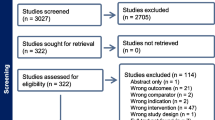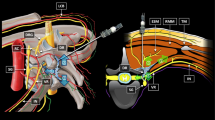Abstract
Lipo-prostaglandin E1 (lipo-PGE1) is reported to be effective in the treatment of intermittent neurogenic claudication associated with lumbar spinal stenosis. However, the underlying mechanisms by which lipo-PGE1 improves the neurological symptoms have not been fully clarified. We examined the effects of lipo-PGE1 on blood flow and oxygen pressure in the lumbar nerve roots in cats and in patients with lumbar spinal stenosis. In anesthetized cats, blood flow and oxygen pressure in the L7 nerve root were measured with a laser-Doppler flowmeter and a polarographic oxygen monitor, respectively. Lipo-PGE1 (0.075 and 0.15μg/kg, i.v.) significantly increased blood flow and oxygen pressure in the nerve roots, following transient decreases. When the dural tube was compressed by a balloon at the L6 level, lipo-PGE1 (0.15 μg/kg) significantly increased blood flow and oxygen pressure in the nerve roots. Lipo-PGE1 also increased the intraoperative nerve-root blood flow in seven of ten patients with lumbar spinal stenosis. The results suggest that one of the favorable effects of lipo-PGE1 on neurogenic claudication is to increase nerve-root blood flow and oxygen pressure.
Similar content being viewed by others
References
Blau JN, Logue V. Intermittent claudication of the cauda equina. Lancet 1961;I:1081–6.
Carlson LA, Olsson AG. Intravenous prostaglandin E1 in severe peripheral vascular disease. Lancet 1976;II:810.
Clifford PC, Martin MFR, Sheddon EJ, et al. Treatment of vasospastic disease with prostaglandin E. BMJ 1980;281:1031–4.
Evans JG. Neurogenic intermittent claudication. BMJ 1964;2:985–7.
Hoshi K, Mizushima Y, Kiyokawa S, et al. Prostaglandin E1 incorporated in lipid microspheres in the treatment of peripheral vascular diseases and diabetic neuropathy. Drugs Exp Clin Res 1986;12:681–5.
Ito K, Nagashima K, Takenobu T, et al. Effect of OP-1206-α-CD on cauda equina blood flow in dog cauda equina with experimental compression (in Japanese). Kiso to Rinsho (Clinical Report) 1995;29:2577–85.
Kavanaugh GJ, Svien HJ, Holman CB, et al. Pseudoclaudication syndrome produced by compression of the cauda equina. JAMA 1968;206:2477–81.
Kikuchi S, Hoshika I, Matsui T, et al. Neurogenic intermittent claudication in lumbar spine diseases (in Japanese). Seikeigeka (Orthopaedic Surgery) 1986;37:1429–39.
Mizushima Y, Hamano T, Yokoyama K. Tissue distribution and anti-inflammatory activity of corticosteroids incorporated in lipid emulsion. Ann Rheum Dis 1982;41:263–7.
Mizushima Y, Yanagawa A, Hoshi K. Prostaglandin E1 is more effective, when incorporated in lipid microspheres, for treatment of peripheral vascular diseases in man. J Pharm Pharmacol 1983;35:666–7.
Mizushima Y. Lipid microspheres as novel drug carriers. Drugs Exp Clin Res 1985;11:595–600.
Mizushima Y, Shiokawa Y, Homma M, et al. A multicenter double-blind controlled study of lipo-PGE1, PGE1 incorporated in lipid microspheres, in peripheral vascular disease secondary to connective tissue disorders. J Rheumatol 1987;14:97–101.
Murakami M, Takahashi K, Yamagata M, et al. Effects of intravenous administration of lipo PGE1 for lumbar spinal canal stenosis (in Japanese) Rinsho-Seikeigeka (Clinical Orthopaedic Surgery) 1992;27:1011–8.
Olmaker K, Rydevik B, Holm S, et al. Effects of experimental graded compression on blood flow in spinal nerve roots. A vital microscopic study on the porcine cauda equina. J Orthop Res 1989;7:817–23.
Ooi Y, Mita F, Satoh Y. Myeloscopic study on lumbar spinal canal stenosis with special reference to intermittent claudication. Spine 1990;15:544–9.
Pardy BJ, Hoare MC, Eastcott HHG, et al. Prostaglandin E1 in severe Raynaud's phenomenon. Surgery 1982;92:953–65.
Rydevik B, Brown MD, Lundborg G. Pathoanatomy and pathophysiology of nerve root compression. Spine 1984;9:7–15.
Rydevik B, Holm S, Brown MD, et al. Diffusion from the cerebrospinal fluid as a nutritional pathway for spinal nerve roots. Acta Physiol Scand 1990;138:247–8.
Torihata Y, Takahashi K, Kawahara N, et al. Efficacy of lipo-PGE1 for neurogenic intermittent claudication (in Japanese). Sinyaku to Rinsho (Journal of New Remedies and Clinics) 1993;42:1494–502.
Wilson CB. Significance of the small lumbar spinal canal: Cauda equina compression syndromes due to spondylosis. J Neurosurg 1969;31:499–506.
Author information
Authors and Affiliations
About this article
Cite this article
Sekikawa, T., Murakami, M., Takahashi, K. et al. Effects of lipo-prostaglandin E1 on blood flow and oxygen pressure in lumbo-sacral nerve roots. J Orthop Sci 2, 289–294 (1997). https://doi.org/10.1007/BF02488912
Received:
Accepted:
Issue Date:
DOI: https://doi.org/10.1007/BF02488912




